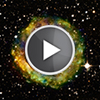CXC Home | Search | Help | Image Use Policy | Latest Images | Privacy | Accessibility | Glossary | Q&A
Tour of G11.2-0.3
Quicktime MPEG
While they may sound like very different and distinct fields, astronomy and history can intersect in very interesting and important ways. Take, for example, historical supernovas and their remnants. These are objects that astronomers observe today and that can also be linked to recordings in previous centuries or even millennia. Being able to tie a credible historical event with a supernova remnant observed today provides crucial information about these explosive stellar events.
Until now, the supernova remnant G11.2-0.3 was considered one of these historical supernova remnants. Previous studies have suggested that G11.2-0.3 was created in a supernova that was witnessed by Chinese astronomers in 386 CE. New Chandra data, however, of this circle shaped debris field, indicate that is not the case. The latest information from Chandra reveals that there are dense clouds of gas that lie between Earth and the supernova remnant. Therefore, it is not possible that much optical light from the supernova - the kind of light humans can see - would have penetrated the clouds and been visible with the naked eye at Earth. While it may no longer be a historical supernova remnant, G11.2-0.3 remains an intriguing and beautiful object that astronomers will continue to study.
[Runtime: 02:19]
Quicktime MPEG
While they may sound like very different and distinct fields, astronomy and history can intersect in very interesting and important ways. Take, for example, historical supernovas and their remnants. These are objects that astronomers observe today and that can also be linked to recordings in previous centuries or even millennia. Being able to tie a credible historical event with a supernova remnant observed today provides crucial information about these explosive stellar events.
Until now, the supernova remnant G11.2-0.3 was considered one of these historical supernova remnants. Previous studies have suggested that G11.2-0.3 was created in a supernova that was witnessed by Chinese astronomers in 386 CE. New Chandra data, however, of this circle shaped debris field, indicate that is not the case. The latest information from Chandra reveals that there are dense clouds of gas that lie between Earth and the supernova remnant. Therefore, it is not possible that much optical light from the supernova - the kind of light humans can see - would have penetrated the clouds and been visible with the naked eye at Earth. While it may no longer be a historical supernova remnant, G11.2-0.3 remains an intriguing and beautiful object that astronomers will continue to study.
[Runtime: 02:19]
(Credit: NASA/CXC/A. Hobart)
Return to G11.2-0.3 (August 17, 2016)



